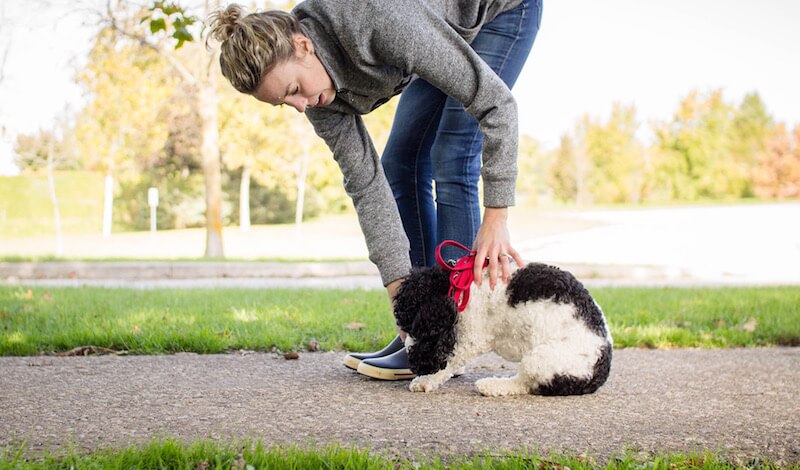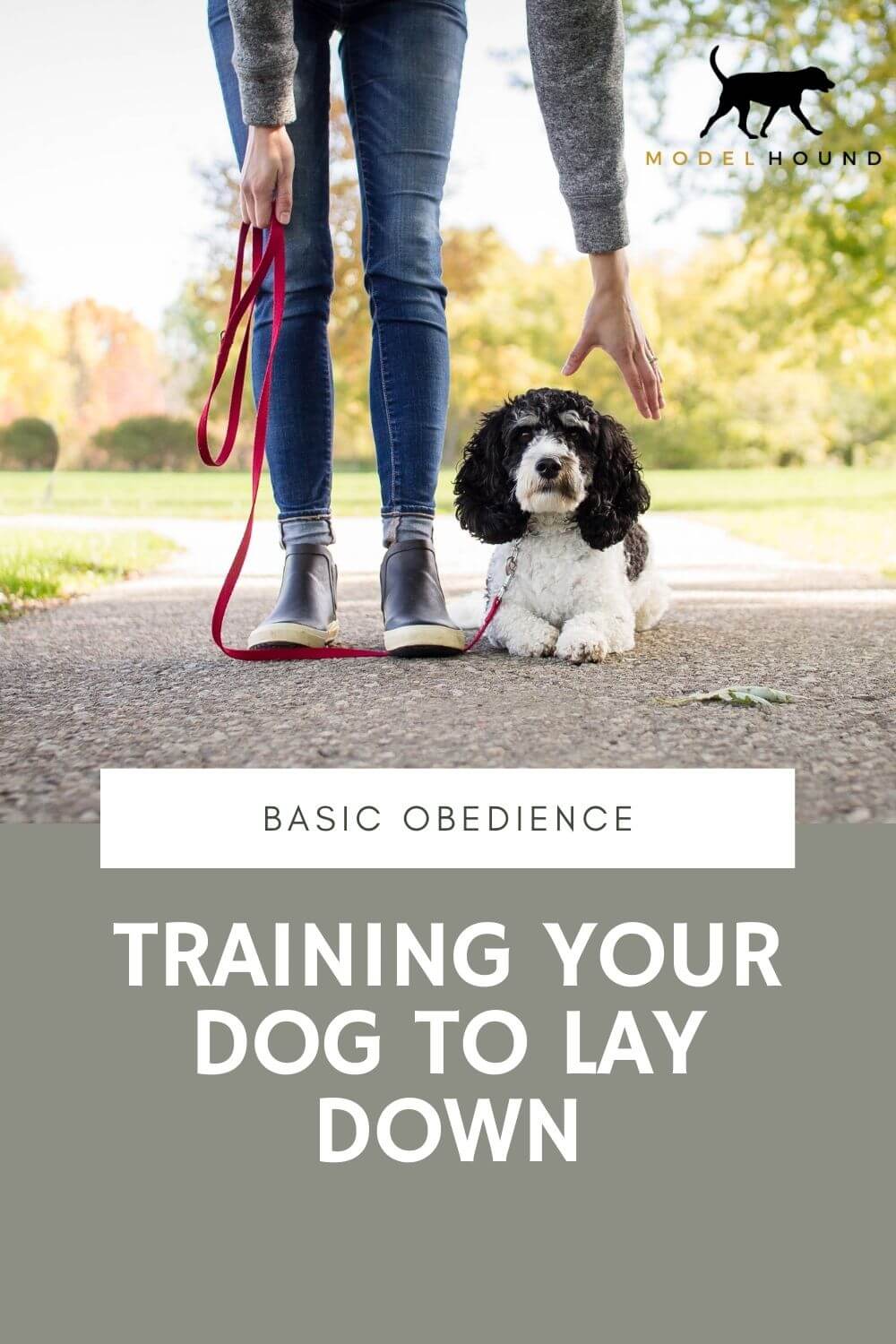Train Your Dog to Lie Down Without a Fuss
You're stumped. You've tried different ways to train your dog to lie down, but nothing is working!
Basic training has likely been moving along pretty well for you and your dog, without too many hiccups. Sit? Check. Stay? Got it. Down? Not exactly...
Why, oh, why is this command so hard to teach?
Try thinking of it from your dog's point of view. A down is a submissive and vulnerable position for a dog.
While some dogs with a more soft temperament may have no problem lying down for you, others will fight it with all they've got! So does that mean you should give up?
Of course not! It simply means that you need to work around these roadblocks, and show your dog that he can trust you in this exercise as well. Training from a foundation of trust will always produce better results than fear-based training.
But First, Basics
I get it, you're here to learn how to train a down command to your dog. But training works in building blocks, starting with the simplest exercises and then building up from there.
So if you want to just learn the down command, then read on. But if you think that your dog would benefit from starting at the beginning - and I promise, he will! - then pop over to each of the following how-to's and spend a few weeks laying the foundation work before coming back to this exercise:
- Train your dog to sit.
- Train your dog to heel nicely on leash.
- Train your dog to stay.
Get Your Tools Ready
There are only a few tools you'll need to train your dog to lie down.
- A collar - Click the link for some advice to choose a dog training collar.
- A leash - 6 feet is a good length, in nylon, leather or Biothane.
- A few soft, smelly treats - No crunchy biscuits! You need something with a lot of smell to use as a lure.
While I normally use treats sparingly in training, this exercise is a bit different, at least at first. You’re going to use a treat every single time you down your dog for the first 14 consecutive days.
Using a treat as a scent lure each time conditions the dog to be more relaxed for the exercise. That's the secret to a fight-free down!
And always practice before feeding time, because if your dog's not hungry, well, he won't be that motivated to follow the treat.
What about telling the dog to stay? Not just yet. You can't expect your dog to be able to hold a down-stay command right off the hop. Remember the building blocks?
Work on practicing to train your dog to lie down for a week, every single day, before attempting leaving his side on a stay command.
4 Steps to a Fuss-free Down
1. Hold the leash in your left hand, with a treat in your right hand.
Before you begin, gently pull your dog's collar up high behind his ears and under his chin. This is called the "tender zone", and any correction that you give will be the most effective with the collar in this position as opposed to hanging down low on the neck. There's way too much muscle there!
Have your dog sit at your left side with a leash clipped on to the collar. Gather up the leash nice and neat, and hold it in your left hand, gently resting your hand on his withers (the area just behind the shoulders).
Put a small soft treat in your right hand, holding it between your thumb and finger.
2. Give a verbal "down" command and lure with the treat.
Once you're ready and your dog is sitting calmly:
- Touch the treat to his nose.
- Make an "L shape" with the treat, by pulling it straight down so that it hits the ground between his paws and then pulling it straight out in front of the dog along the ground.
- As you're moving the treat, say "Doooooowwwwwwn", drawing out the word the whole time your dog's body is changing positions.
 Using a treat to lure Milo down while giving a verbal command.
Using a treat to lure Milo down while giving a verbal command.Your dog should follow the treat down, crawling forward into a down position as the treat is pulled forward from his paws. But what if he doesn't seem to want it?
That's where your left hand comes in. As it's already resting on your dog's withers, gently push down as you lure with the treat.
Or try using a different treat, something that is completely new and especially enticing! Slices of hotdog, small pieces of cheese, freeze dried liver, crumbled real bacon, small bits of steak. You know - the yummy stuff.
3. Take precautions to make sure your dog can't get up again!
Of course, most dogs will jump right up again as soon as they get that treat. Especially if he's gotten away with it in the past. No judgment here, okay?
We're going to anticipate that though, and make sure it's just not an option for your dog this time around! Set your dog up for success. The more successful he is, the quicker he will learn and the more progress you will make.
As soon as your dog is in the down position and happily munching on the treat you've just popped in his mouth, quickly put your left foot on the leash as close to the clasp as you can without pulling the collar tight, and move the leash handle into your right hand.
The second thing you need to do is hover just above the dog's withers with your open left hand. Shape your hand into a big "C", with your thumb over one side of his body and the fingers over the other.
Now if Rover tries to get up, the leash will automatically correct him down (as it's under your foot), and you will also quickly drop your left hand to push down on his withers. Just a quick push down and then get your hand off your dog's withers again.
Double check that you put the leash under the ball of your foot, not the arch, or it will just feed through the gap and your dog will be able to get up!
You don't want to leave your hand resting on the dog's back once he's in the down position. Why? He'll think that he only has to stay down while your hand is touching him! So just hover.
Here's the only caveat. If you aren't quick enough to push your dog back down by the withers, or you've forgotten to put your foot on the leash - regardless of the reason - if the dog gets up, you have to grab another treat and start over from the beginning.
Why? Your dog is still learning. A correction from a stand or sit into a down is too harsh for a novice dog.
4. Finish the exercise.
All dog training exercises need a start and end point, and teaching your dog a down command is no different.
The first few times you down your dog, only have him down for around 10 seconds. And don't forget to praise him while he's lying down nicely!
Go easy on the physical praise though, or you'll end up with him rolling around on the ground for belly rubs.
Then nonchalantly take your left foot off the leash, but stay hovering with your left hand over his withers, just in case he tries to get up.
Give it a few seconds like this so that the dog doesn't start thinking that your foot coming off the leash means he can get up. Then give the command to heel, if your dog knows that command, and walk forward.
If heeling isn't in your pup's repertoire yet, give a verbal release command, such as "Okay!" in a happy, upbeat tone of voice. You may need to give him a gentle lift under the belly to get him up at first, and then praise when he moves out of the down position.
Homework!
You knew it was coming, didn't you? There's no success without practice!
I mentioned it earlier, but here's the formula to follow:
Use a treat for the down command every day for 14 consecutive days, doing a minimum of 12 downs per day.
On day 15, cut the treats out cold turkey. You will go through the same motions, but without a treat between your fingers, and your dog will now down on your voice and hand signal only.
If you miss a day - I get it, life is busy - start back on Day 1 with the treats.
As you practice, make sure that you don’t only make your dog lie down on the same old surface, such as the sidewalk. Vary the terrain that you ask him to down on, so that he becomes conditioned to obey you even if it feels different under his belly.
So where should you practice? Everywhere! On pavement, cement, short grass, long grass, carpet, tile, gravel… and in different weather, too.
And THAT is how to train a dog to lie down without a fuss.
- Home
- Basic Training
- Down Command


